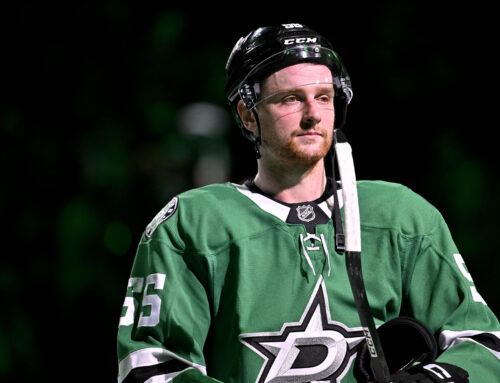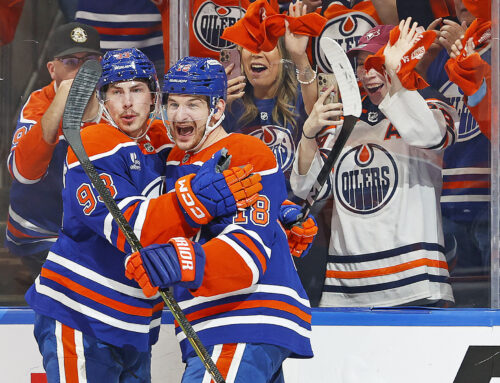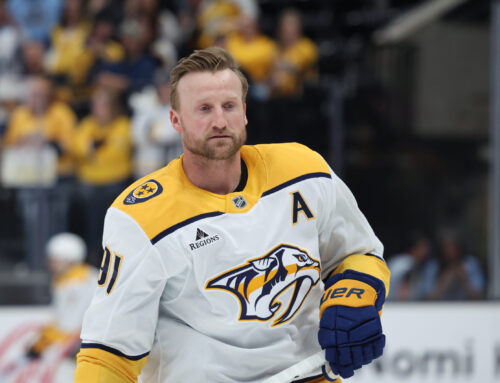
Just which players are fantasy-best depends on your league. It’s a very close call for many. Sometimes top scorers have poor plus/minus, penalty minutes, hits or blocked shots stats rendering them less valuable in multi-category leagues. It’s impossible to factor in all the various league scoring systems out there. With the growing number of pools emphasizing more than points totals, I’ll lean more multi-cat here, acknowledging that points often are weighted more heavily than other stats in them. I mostly assigned each player with multiple-position eligibility their dominant position for the purposes of this column, so your parameters may vary again. Here are some stats, in no binding order, to see where things ended up for some of the statistically-best Western left wings last year.
2016-17 WESTERN CONFERENCE LEFT WINGS
|
Name |
Team |
GP |
G |
A |
Pts |
+/- |
PIM |
Hits |
Bks |
FW |
FO% |
PPP |
SOG |
|
DAL |
77 |
26 |
43 |
69 |
-9 |
66 |
89 |
47 |
212 |
51.4 |
26 |
201 |
|
|
EDM |
81 |
27 |
15 |
42 |
+13 |
95 |
189 |
23 |
6 |
40.0 |
6 |
178 |
|
|
NSH |
82 |
31 |
27 |
58 |
-4 |
32 |
97 |
26 |
5 |
27.8 |
9 |
234 |
|
|
CGY |
72 |
18 |
43 |
61 |
-7 |
4 |
9 |
14 |
0 |
0.0 |
16 |
182 |
|
|
ANA |
71 |
33 |
18 |
51 |
+10 |
12 |
81 |
32 |
62 |
42.2 |
12 |
177 |
|
|
EDM |
82 |
23 |
27 |
50 |
-3 |
50 |
202 |
20 |
4 |
57.1 |
25 |
175 |
|
|
STL
📢 advertisement:
|
78 |
19 |
36 |
55 |
+14 |
18 |
71 |
43 |
67 |
47.9 |
9 |
179 |
|
|
MIN |
81 |
26 |
43 |
69 |
+23 |
12 |
50 |
50 |
16 |
48.5 |
20 |
177 |
|
|
Matthew Tkachuk |
CGY |
76 |
13 |
35 |
48 |
+14 |
105 |
65 |
22 |
8 |
34.8 |
13 |
142 |
|
WPG |
82 |
25 |
39 |
64 |
+1 |
38 |
43 |
28 |
0 |
0.0 |
12 |
204 |
|
|
now CHI |
82 |
24 |
29 |
53 |
+23 |
8 |
24 |
26 |
4 |
44.4 |
3 |
210 |
|
|
Clayton Keller |
AZ |
3 |
0 |
2 |
2 |
-3 |
0 |
0 |
0 |
0 |
0.0 |
1 |
0 |
If we’re talking multi-categories Jamie Benn’s power play points, hits, blocks, and faceoff numbers offset 2016-17’s comparative deficit in goals and plus-minus and place him at the top. With Alexander Radulov joining the party and probably that top line along with Benn and Seguin in Dallas, Benn could smash last year’s totals and set career highs.
Patrick Maroon’s value is highly dependent upon your league settings. If it values hits and penalty minutes as much as mine, he’s a top three left wing. If not Maroon drops perhaps out of the top ten, although one can’t underestimate the scoring potential accompanied by that spot next to McDavid. His 178 shots, 189 hits and 27 goals were by far career highs last year. If coach Todd McLellan keeps him on the same line, Maroon could increase all three with a healthy 2017-18, although it will be hard to duplicate his 15.2 shot percentage.
With 63, 64 and 58 points over the past three campaigns Filip Forsberg is a safe and smart selection as long as you aren’t betting on tons of peripherals. Last year’s 234 shots on goal led top West left wing candidates and 97 hits was respectable, but he’s generally had a mediocre plus-minus over his career. Unfortunately his power play points dropped from a career-high 23 in 2015-16 to just nine last year. Expect something closer to the mean in 2017-18.
After a nearly 70-point campaign and three-year, $17.25M agreement, Mikael Granlund should again score in bunches and rack up an impressive plus/minus. And he’s still LW eligible in several leagues, although most expect him to predominantly play on the right side next year. He may regress from last year’s 14.7 shot percentage with his previous high at 8.8% but if he skates next to Mikko Koivu and Jason Zucker, and considering he only saw 37.84% offensive zone starts in 2016-17, Granlund should at least approach 60 points. With playing the pivot at times is a possibility, and just a year removed from earning 528 faceoff wins, Granlund also offers potential points from the circle.
Like Maroon, Matthew Tkachuk’s another left wing whose rank fluctuates relative to your league’s peripherals, especially penalty minutes. He finished fifth among all West skaters (even ahead of Ryan Reaves) last year. His 34 minor penalties sat just behind Byfuglien’s conference high of 40. Plan on Tkachuk’s scoring (48 points with 35 assists) and hits to rise in his second NHL year, along with another good plus-minus showing next to Mikael Backlund and Michael Frolik on that electric 3M line. In year two, it’s not a stretch to envision his 9.2% shot success increasing. And speaking of offensive zone starts, while it’s criminal to use the words sheltered and Tkachuk on the same page his 35.02% could also jump, likely creating more scoring opportunities.
Flame teammate and Lady Byng recipient Johnny Gaudreau offers very little in terms of peripherals (four penalty minutes and nine hits last year) but he should see a major scoring upswing after missing 2016-17 training camp and more with his mid-November, Wild chop-induced broken finger. While 61 points with 43 assists certainly isn’t bad, expect something closer to his 30-goal, 78-point previous campaign, and a return to plus after registering a minus-7 last year, his first campaign under par. After sporting a 9.9 shot percentage, we’ll likely see Gaudreau return to somewhere near his previous years’ 13.8% and 14.4%. Also expect those power-play points to creep back into the twenties after just 16 last year. I doubt he’ll challenge Benn, but a top-three finish wouldn’t surprise.
Rickard Rakell plays every forward position from time-to-time, and he’s left-wing eligible in my league so he deserves to be somewhere in the middle of the West’s best pack, with the aftermath of his tops-in-class 33 goals and decent hit totals (81). It’s doubtful he rekindles his 2016-17 shot percentage of 18.6, especially since he nowhere near sniffed that in his previous campaigns with 8.6% and 11.8% marks, but having never finished a campaign below 50% offensive zone starts it’s clear Anaheim tries to put him in the best possible spots to score. He approached a near career-high of 55.62% last year. That being said, versatility permits Rakell to skate alongside any Duck from Getzlaf to Wagner. Monitor closely as placement may impede or enhance his value greatly.
Milan Lucic profiles along with teammate Maroon and Tkachuk as an all-around multi-category asset. Topping the chart in hits with 202 last year, but a bit lighter than those two with a career low minutes-per game resulting in just 50 PIM, Lucic should finish the campaign around 50 points once again and could build upon 2016-17’s career-best 25 power play points. That’s what happens when you serve on the top unit with Connor McDavid and Leon Draisaitl. He may even top last year’s 13.1 shot percentage continuing on Edmonton’s second line as he’s topped that five times in his ten-year career, surpassing 17 percent thrice.
With a great chance of maintaining the left wing spot on either the Mark Scheifele – Blake Wheeler or Bryan Little – Patrik Laine line, Nikolaj Ehlers should produce another 60 points at minimum and perhaps increase last year’s 12 power play points. Not the greatest peripherals across the board, but likely will have another close to even plus-minus and great scoring potential. His 12.3 shot percentage compared with the previous year’s 9.0% accompanied a 10-goal increase to 25, and looks to stay near that level considering all the developing and established offensive talent in Winnipeg.
Will the Brandon Saad – Jonathan Toews reunion yield favorable results? We’ll see. In multi-category leagues you’re taking Saad for his scoring and likely a good plus-minus (plus-23 last year with Columbus and a plus-44 in his previous two full campaigns and one strike-shortened year with Chicago). Even if Toews really has lost something, I’m betting the 24-year-old Saad still puts up at least 50 points. Last year’s shot success rate was around his career average at 11.5% and his offensive zone starts percentages have hovered in the upper 50’s throughout his career, peaking at 63.91% in 2013-14. Not a multi-category star as his hits and blocks totals were just 24 and 26 respectively, and a meager three power-play points last year was a drop off from his even career-low numbers, but if your league heavily values 5×5 scoring Saad is worth a reasonably high selection.
Clayton Keller will take a big step next year, I’m betting as a second line left wing with significant power play minutes. With the additions of Derek Stepan, perhaps Dylan Strome hitting the NHL running, and further development of Max Domi (who could easily make this list if he returns to rookie year scoring and PIM form alongside Stepan), Brendan Perlini, and Christian Dvorak along with a healthy and revitalized Oliver Ekman-Larsson, there should be more goals to go around. If all goes well, Keller enters the 50-point neighborhood with about 25 goals and 25 assists and slots in near the top-ten of left wings in the West, mainly due to his scoring and power play totals. Don’t expect tons of peripheral value, except perhaps some faceoff wins if AZ tests him at the pivot.
Jaden Schwartz continues to hold solid scoring value as left wing on the Tarasenko line, and should again provide point totals in the mid-50s. In his sixth full year, Schwartz could see an increase after coming off a career low 10.6% shot percentage. He provides next to no penalty minutes and his power-play point totals were just nine and five the last two years despite skating frequently with Tarasenko, but 2016-17 saw Schwartz’ best hits campaign yet with 71. He’ll also add a few faceoffs here and there, registering 67 FOW last year.
Follow me on Twitter @KWcrosscheck





 FLA
FLA EDM
EDM MTL
MTL MIN
MIN DAL
DAL N.J
N.J NYI
NYI S.J
S.J CAR
CAR COL
COL
